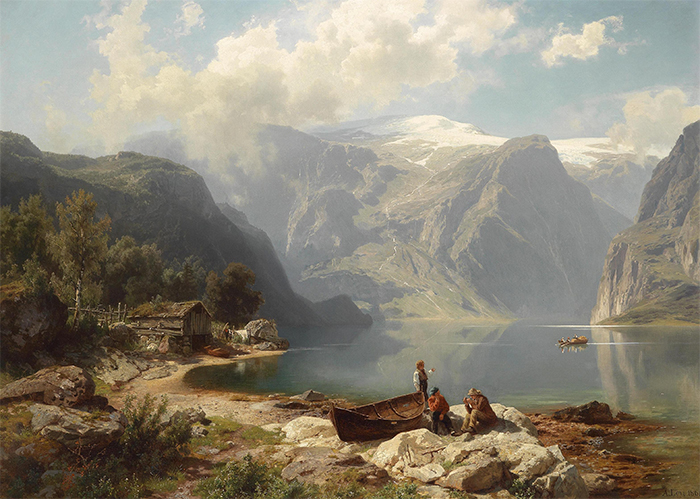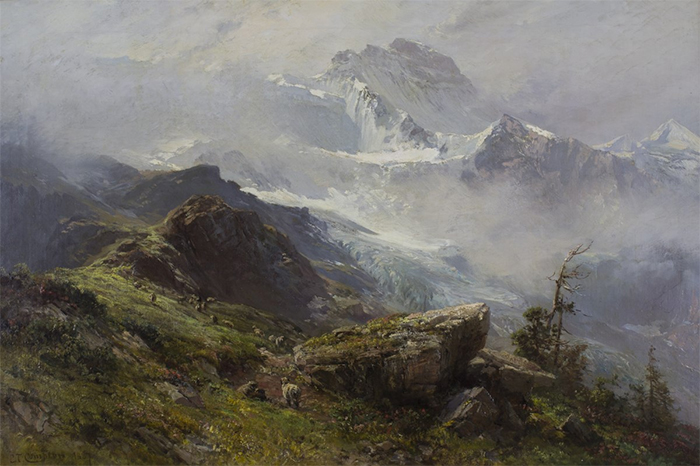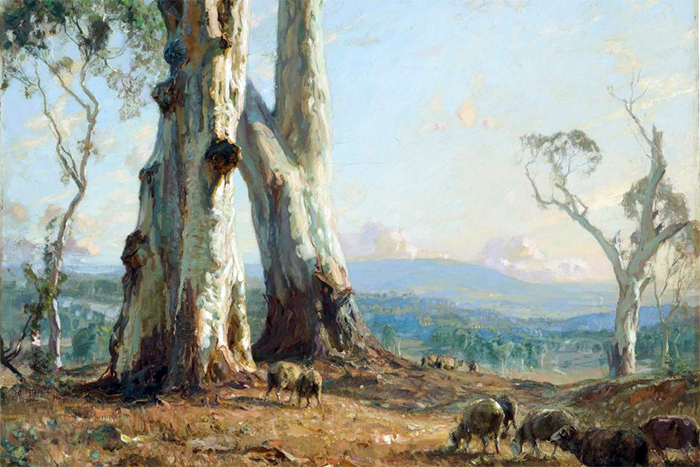The Top Ten Historical Landscape Artists That Will Inspire You!
Landscape art has always been a favorite subject of mine. Even as a kid, I used to draw or paint constantly. I'm a traditional realism and plein-air landscape painter. I love vibrant, colorful, and natural-looking landscapes. Many of my influences are historical painters from the 19th Century.
The landscape paintings produced during the 19th and early 20th centuries are among the best I've ever seen. They stressed color, tone, composition, and atmosphere.
This blog post lists my ten loving historical painters who have inspired and influenced my artwork. I hope that these historical painters inspire you, too.
1. Albert Bierstadt

Albert Bierstadt, born in Germany in 1830, emigrated with his parents to America when he was one year old. He began drawing at a young age and started oil painting in 1851. Bierstadt studied art in Dusseldorf, Germany, in 1853 before coming back to America.
Epic is a term that describes Albert Bierstadt’s artworks, where he skillfully created his artworks to portray a poetic story. As part of a career-long journey of discovery, he painted breathtaking landscapes across America on large canvases.
Bierstadt painted many grandiose Westerns, including the Rocky Mountains. He was known for his dramatic lighting effects. Many private collections bought his outstanding paintings at prices that were then staggeringly high.
I like Albert Bierstadt as an artist. I enjoy the drama in his work and how he uses tone to create atmospheric perspectives.
2. Edgar Payne

Edgar Alwin Payne is an American plein-air painter who was born in 1883. He was known for his vivid paintings and loose gestural brushes. He painted scenes throughout America and Europe, but the Sierra Nevada and Alpine mountains captured his attention. He painted Southwest desert pictures and Native Americans riding horses in the distance.
At the time, Edgar Payne was a unique artist amongst his peers who painted idyllic, quieter landscapes. He chose to paint rugged and vital landscapes influenced by his love of nature. Edgar Payne, an avid traveler and painter of sublime landscapes of Europe's mountains and deserts, is known for his paintings. He was also one of the first painters to explore the Sierra Nevada to find subject matter.
Edgar Payne's paintings are particularly inspiring to me as a plein-air painter. I admire the vibrancy in his work through loose brushwork, color, and tone. This is a visual guide on how to paint. Amazing pictures that deserve your attention.
3. August Wilhelm Leu

This German painter is the next master on my list. His mountain scenes made him famous. He spent much time in Norway and the Alps, where he painted beautiful paintings. August was born in 1818. Later, he was part of the Romantic School. This school started in Europe in the 19th century. Painters of this school focused a lot on emotion and individualism.
August spent some years in different cities like Brussels and Dusseldorf. In 1882, Leu decided to move back to Berlin. There, he became a royal professor at the Academy of Art.
I really like Leu's paintings. The romantic feel in them is incredible. I admire how he paints mountains. This is something I’d like to learn. He aims at minimalistic colors that have a lot of depth at the same time. His artworks are full of romantic ideals.
4. Peder Monl Monsted

Peder was a renowned painter from Denmark. He was a true master of realistic depictions of landscapes, seascapes, and various other scenes. Peder was born in 1859 in Denmark. He liked to depict countryside scenes and farms in his paintings. He started painting at a young age and honed his skills at the Royal Academy of Fine Arts between 1875 and 1879.
Peder had a knack for detail and color, evident in his extensive work. He was quite the traveler, venturing to places like North Africa and the Middle East, where he created many notable paintings. His art was a regular feature in exhibitions in cities like Munich and Paris.
I really admire Monsted and his historical landscape art. The paintings he did of forests and woods are particularly striking to me. The vibrant, natural colors and the balance between detail and the freedom of his brushwork are just amazing. If you take a closer look, the craftsmanship in each stroke is impressive.
5. Frederick Waugh

Frederick Judd Waugh is an American painter who was born in 1861. He died in 1940. He was primarily a marine painter who painted energetic and epic seascapes focusing on the breaking waves, rocks, and other elements.
Waugh's use of natural organic colors and tonality in his paintings has created a sense of depth that I find very appealing. The emphasis on breaking waves draws you into the painting, creating a feeling of being there. I like the way he emphasizes rocks, especially when juxtaposed with a large swell.
For inspiration when painting seascapes, Frederick Judd Waugh has always been one of my favorite painters.
6. Edward Theodore Compton

Edward Theodore Compton, born in London (UK), emigrated to Germany at a very young age with his family. He was self-taught and had attended art school. He became active in the art community after emigrating from Germany. Both he and his father were well-known for their teaching.
Compton, an illustrator and mountaineer, is known for his paintings and drawings of breathtaking mountain scenery. Compton traveled to Austria, Corsica, North Africa, Spain, Scandinavia, and Scandinavia and rendered mountain landscapes with oils, inks, and watercolors.
Edward Theodore Compton’s paintings are characterized by his compositions. Many depict mountainous landscapes from steep slopes, adding a sense of awe and reverence. The use of organic colors and contrasting light and dark areas add to the grandeur of his paintings.
7. Even Ulving

Even Ulving, who is also a 19th-century landscape artist I love, continues the theme of mountains. Ulving, a Norwegian artist born in 1863, painted many mountain and water scenes.
I love Ulving’s compositions, which are characterized by his accessible style of painting and gestural brushwork. The vibrant colors and organic hues are also a great combination. His pictures often display magical lighting effects. A dramatic contrast of shadow and light is a real spice in his paintings. His works inspire me a lot.
8. Hans Heysen

Born in Germany, Hans Heysen moved to Adelaide, South Australia, with his family when he was seven. He's famous in Australia for his art, especially his drawings and paintings of big gum trees and farm scenes.
Heysen started learning art in night school when he was young and quickly got noticed. At twenty, some art lovers in Adelaide sponsored him to study in France for four years.
I've visited Australia a few times and seen his work at the Art Gallery of New South Wales in Sydney. Trust me, his work is beautiful! The way he paints tree bark and the color changes in the gum trees is genius. Whenever I see his work, I feel like painting some gum trees myself.
9. Ivan Shishkin

Ivan Shishkin, born in 1832 in Russia, is known for his stunning tree and forest paintings. He studied in Moscow and St. Petersburg and graduated at the top of his class.
Shishkin painted in different countries like Switzerland and Germany and showed his work in various cities, including Paris and Moscow. He had a technical approach to painting nature and was also skilled in drawing and printmaking.
I'm impressed by Shishkin’s attention to detail. I love his paintings and hope I can see them up close someday!
10. William Trost Richards

William was Born in Philadelphia in 1833. He was an American painter known for his dramatic seascapes and landscapes. He was part of the Hudson River School style of painting.
Richards painted a lot of American landscapes, like the Catskills and Adirondacks. However, he also spent some time in Europe. He painted in England, Scotland, and Norway. Here’s a funny fact. William Trost Richards even created a painting of the coastline of Guernsey, where I spent my childhood.
Richards is one of my go-to artists for inspiration for seascapes and landscapes. I really like the way he painted waves. There is something fascinating in the depth of his paintings. He is a true master of drama and dynamics.
No Comments Yet...